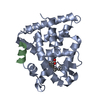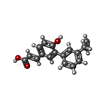Entry Database : PDB / ID : 4oc7Title Retinoic acid receptor alpha in complex with (E)-3-(3'-allyl-6-hydroxy-[1,1'-biphenyl]-3-yl)acrylic acid and a fragment of the coactivator TIF2 Nuclear receptor coactivator 2 Retinoic acid receptor RXR-alpha Keywords / Function / homology Function Domain/homology Component
/ / / / / / / / / / / / / / / / / / / / / / / / / / / / / / / / / / / / / / / / / / / / / / / / / / / / / / / / / / / / / / / / / / / / / / / / / / / / / / / / / / / / / / / / / / / / / / / / / / / / / / / / / / / / / / / / / / / / / / / / / / / / / / / / / / / / / / / / / / / / / / / / / / / / / / / / / / / / / / / / / Biological species Homo sapiens (human)Method / / / / Resolution : 2.5 Å Authors Leysen, S. / Scheepstra, M. / Brunsveld, L. / Milroy, L.G. / Ottmann, C. Journal : Angew.Chem.Int.Ed.Engl. / Year : 2014Title : A natural-product switch for a dynamic protein interface.Authors : Scheepstra, M. / Nieto, L. / Hirsch, A.K. / Fuchs, S. / Leysen, S. / Lam, C.V. / in het Panhuis, L. / van Boeckel, C.A. / Wienk, H. / Boelens, R. / Ottmann, C. / Milroy, L.G. / Brunsveld, L. History Deposition Jan 8, 2014 Deposition site / Processing site Revision 1.0 Oct 8, 2014 Provider / Type Revision 1.1 Nov 22, 2017 Group / Category Revision 1.2 Aug 17, 2022 Group / Derived calculationsCategory database_2 / pdbx_struct_assembly ... database_2 / pdbx_struct_assembly / pdbx_struct_assembly_gen / pdbx_struct_assembly_prop / pdbx_struct_oper_list / struct_ref_seq_dif / struct_site Item _database_2.pdbx_DOI / _database_2.pdbx_database_accession ... _database_2.pdbx_DOI / _database_2.pdbx_database_accession / _pdbx_struct_assembly.details / _pdbx_struct_assembly.method_details / _pdbx_struct_assembly.oligomeric_count / _pdbx_struct_assembly.oligomeric_details / _pdbx_struct_assembly_gen.oper_expression / _struct_ref_seq_dif.details / _struct_site.pdbx_auth_asym_id / _struct_site.pdbx_auth_comp_id / _struct_site.pdbx_auth_seq_id Revision 1.3 Feb 28, 2024 Group / Category / chem_comp_bond
Show all Show less
 Yorodumi
Yorodumi Open data
Open data Basic information
Basic information Components
Components Keywords
Keywords Function and homology information
Function and homology information Homo sapiens (human)
Homo sapiens (human) X-RAY DIFFRACTION /
X-RAY DIFFRACTION /  SYNCHROTRON /
SYNCHROTRON /  MOLECULAR REPLACEMENT /
MOLECULAR REPLACEMENT /  molecular replacement / Resolution: 2.5 Å
molecular replacement / Resolution: 2.5 Å  Authors
Authors Citation
Citation Journal: Angew.Chem.Int.Ed.Engl. / Year: 2014
Journal: Angew.Chem.Int.Ed.Engl. / Year: 2014 Structure visualization
Structure visualization Molmil
Molmil Jmol/JSmol
Jmol/JSmol Downloads & links
Downloads & links Download
Download 4oc7.cif.gz
4oc7.cif.gz PDBx/mmCIF format
PDBx/mmCIF format pdb4oc7.ent.gz
pdb4oc7.ent.gz PDB format
PDB format 4oc7.json.gz
4oc7.json.gz PDBx/mmJSON format
PDBx/mmJSON format Other downloads
Other downloads 4oc7_validation.pdf.gz
4oc7_validation.pdf.gz wwPDB validaton report
wwPDB validaton report 4oc7_full_validation.pdf.gz
4oc7_full_validation.pdf.gz 4oc7_validation.xml.gz
4oc7_validation.xml.gz 4oc7_validation.cif.gz
4oc7_validation.cif.gz https://data.pdbj.org/pub/pdb/validation_reports/oc/4oc7
https://data.pdbj.org/pub/pdb/validation_reports/oc/4oc7 ftp://data.pdbj.org/pub/pdb/validation_reports/oc/4oc7
ftp://data.pdbj.org/pub/pdb/validation_reports/oc/4oc7 F&H Search
F&H Search Links
Links Assembly
Assembly

 Components
Components Homo sapiens (human) / Gene: NR2B1, RXRA / Plasmid: pET15b / Production host:
Homo sapiens (human) / Gene: NR2B1, RXRA / Plasmid: pET15b / Production host: 
 Homo sapiens (human) / References: UniProt: Q15596
Homo sapiens (human) / References: UniProt: Q15596 X-RAY DIFFRACTION / Number of used crystals: 1
X-RAY DIFFRACTION / Number of used crystals: 1  Sample preparation
Sample preparation SYNCHROTRON / Site:
SYNCHROTRON / Site:  SLS
SLS  / Beamline: X06DA / Wavelength: 0.97794 Å
/ Beamline: X06DA / Wavelength: 0.97794 Å molecular replacement
molecular replacement Processing
Processing MOLECULAR REPLACEMENT / Resolution: 2.5→47.768 Å / Occupancy max: 1 / Occupancy min: 1 / FOM work R set: 0.6971 / SU ML: 0.33 / σ(F): 1.33 / Phase error: 33.44 / Stereochemistry target values: ML
MOLECULAR REPLACEMENT / Resolution: 2.5→47.768 Å / Occupancy max: 1 / Occupancy min: 1 / FOM work R set: 0.6971 / SU ML: 0.33 / σ(F): 1.33 / Phase error: 33.44 / Stereochemistry target values: ML Movie
Movie Controller
Controller


 PDBj
PDBj













